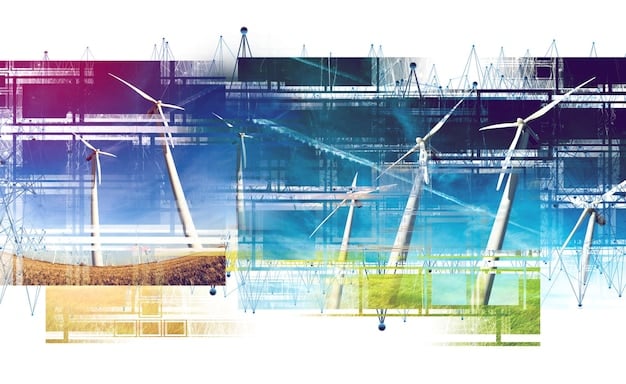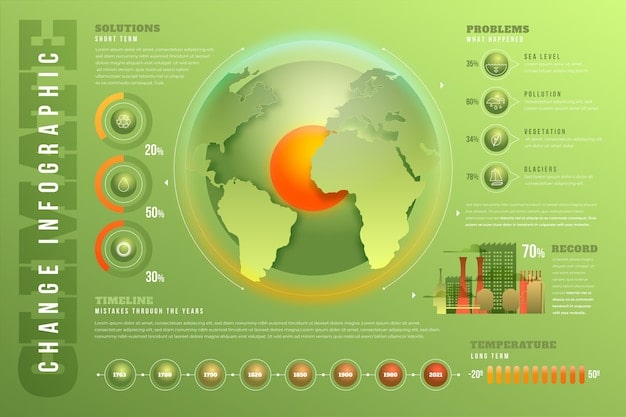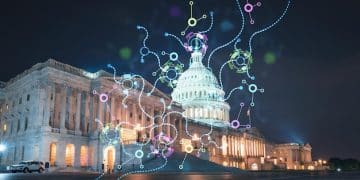US Climate Goals: On Track for 2030?

Advertisements
Analyzing the US Response to Global Climate Change: Are We on Track to Meet 2030 Goals? The United States faces significant challenges in achieving its ambitious 2030 climate targets, with current policy frameworks requiring substantial acceleration and broader adoption of sustainable practices across all sectors to align with commitments made under the Paris Agreement.
Advertisements
The global climate crisis demands urgent action, and nations worldwide are grappling with ambitious targets to mitigate its impacts. In this context, understanding how the United States, a major historical emitter and global economic powerhouse, is responding to this challenge is crucial. This article delves into an in-depth analysis of the US response to global climate change, specifically posing the critical question: Analyzing the US Response to Global Climate Change: Are We on Track to Meet 2030 Goals? We will explore policy frameworks, technological advancements, economic shifts, and societal perspectives to gauge the nation’s trajectory towards its declared climate objectives.
The Ambitious Path: US Climate Commitments and the Paris Agreement
The United States has historically played a complex role in international climate negotiations. Following its rejoining of the Paris Agreement, the nation reaffirmed its commitment to significant emissions reductions. This re-engagement signaled a renewed focus on climate action, setting a target to cut greenhouse gas emissions by 50-52% below 2005 levels by 2030.
Advertisements
This commitment, a cornerstone of the Biden administration’s climate agenda, reflects an urgent recognition of the climate crisis. It requires a rapid systemic transformation across multiple sectors, moving away from fossil fuels towards cleaner energy sources and more sustainable practices.

Historical Context and Evolving Policy
Understanding the current trajectory necessitates a look back at the nation’s sometimes turbulent approach to climate policy. From the Kyoto Protocol’s rejection to the withdrawal from, and re-entry into, the Paris Agreement, the US stance has been subject to political shifts. However, a growing consensus, particularly among younger generations and scientific communities, has pushed for more decisive action.
The current administration has emphasized a “whole-of-government” approach, aiming to integrate climate considerations into all federal operations and departmental policies. This broad strategy seeks to ensure that climate goals are not isolated initiatives but fundamental components of national development and security.
- Re-entry into the Paris Agreement, solidifying international climate standing.
- Setting an ambitious Nationally Determined Contribution (NDC) for 2030.
- Emphasis on a “whole-of-government” strategy for climate integration.
- Executive orders prioritizing clean energy and environmental justice.
The commitment to net-zero emissions by 2050 also underpins the 2030 goals, positioning them as critical intermediate steps towards long-term decarbonization. While ambitious, these targets align with scientific recommendations for limiting global warming to 1.5 degrees Celsius, a threshold critical for avoiding the most catastrophic climate impacts.
In charting its course, the US also faces scrutiny regarding its historical emissions. As a developed nation, there’s an expectation for leadership and greater accountability in reducing carbon footprints and supporting developing countries in their climate transitions. This dual responsibility—domestic action and international cooperation—forms the intricate fabric of the US climate response.
The transition is not merely about environmental protection; it’s framed as an economic opportunity, fostering green jobs, technological innovation, and energy independence. This narrative aims to build broader support for climate policies, appealing to both environmental advocates and economic pragmatists. The political will, however, remains a dynamic and often challenging variable in this complex equation.
Policy Frameworks and Legislative Action: Driving Decarbonization
The Biden administration has introduced several significant policy frameworks aimed at accelerating the decarbonization of the US economy. Central to these efforts is the Inflation Reduction Act (IRA), a landmark piece of legislation that allocates hundreds of billions of dollars to clean energy and climate initiatives.
The IRA’s provisions include substantial tax credits for renewable energy production, electric vehicle purchases, and energy-efficient home improvements. These incentives are designed to accelerate the adoption of clean technologies, reduce consumer costs, and spur domestic manufacturing in critical sectors like batteries and solar panels.
Key Legislative Initiatives and Their Impact
Beyond the IRA, other policies and regulations contribute to the US climate strategy. These include stricter emissions standards for vehicles, investments in energy grid modernization, and initiatives to reduce methane emissions from oil and gas operations. The Department of Energy, Environmental Protection Agency (EPA), and other federal entities are actively developing and implementing programs to support these goals.
For example, the EPA’s proposed rules for power plant emissions are anticipated to drive significant investment in carbon capture technologies and renewable energy sources. These regulatory actions are crucial complements to the IRA’s economic incentives, creating a comprehensive framework for emissions reduction.
- Inflation Reduction Act: Tax credits and incentives for clean energy and climate.
- Stricter vehicle emissions standards.
- Investments in grid modernization and energy storage.
- Methane emissions regulations targeting key industrial sources.
However, the effectiveness of these policies hinges on their successful implementation and sustained political support. Challenges include navigating legal battles, ensuring equitable distribution of benefits, and overcoming potential resistance from entrenched fossil fuel interests. The legislative landscape is constantly evolving, and a change in political leadership could significantly alter the pace and direction of climate action.
Moreover, state and local governments play a vital role. Many states have set their own ambitious climate targets and are implementing complementary policies, often acting as laboratories for innovative climate solutions. This patchwork approach can accelerate progress in some regions while highlighting discrepancies in others.
The collective impact of federal, state, and local policies aims to create a virtuous cycle: technological advances drive down costs, making clean energy more competitive, which in turn reinforces the economic and environmental case for further decarbonization. This integrated policy ecosystem is essential for achieving the ambitious 2030 targets.
Energy Transition and Technological Advancements: Shifting the Grid
The core of the US climate strategy lies in transforming its energy sector, which remains a primary source of greenhouse gas emissions. Significant progress has been made in renewable energy deployment, particularly in solar and wind power, thanks to declining costs and supportive policies.
Investment in renewable energy infrastructure is surging, with new projects coming online across the country. Battery storage technology, crucial for grid stability with intermittent renewables, is also advancing rapidly, becoming more affordable and efficient. These developments are critical for reducing reliance on fossil fuels for electricity generation.
Innovations Driving Change
Beyond utility-scale renewables, technological innovations are transforming other sectors. The rapid adoption of electric vehicles (EVs) is a prime example, driven by a combination of federal incentives, state mandates, and growing consumer demand. Charging infrastructure expansion and advancements in battery technology are accelerating this transition.
In industry and agriculture, the focus is on developing and scaling up technologies for hard-to-decarbonize sectors. This includes innovations in green hydrogen production, carbon capture, utilization, and storage (CCUS) for industrial processes, and sustainable agricultural practices that reduce emissions and enhance carbon sequestration in soils.
- Rapid growth in solar and wind power generation capacity.
- Cost reductions and efficacy improvements in battery storage.
- Accelerated adoption of electric vehicles and charging infrastructure.
- Emergence of green hydrogen and CCUS for industrial decarbonization.
However, scaling these technologies to meet climate targets presents significant challenges. Grid modernization is essential to handle the influx of renewable energy, requiring substantial investment in transmission lines and smart grid technologies. Permitting processes for new energy projects can be lengthy, hindering rapid deployment.
The intermittency of renewable energy sources still necessitates backup power, although this role is increasingly being filled by battery storage and demand-side management. Research and development continue to focus on next-generation clean energy technologies, such as advanced nuclear reactors and geothermal systems, to further diversify the energy mix.
The shift away from fossil fuels also involves managing the decline of traditional energy industries, ensuring a just transition for workers and communities historically dependent on coal, oil, and gas. This socio-economic dimension is as critical as the technological one, requiring careful planning and investment in retraining and economic diversification.
Economic Impacts and Green Job Creation: A New Industrial Revolution?
The transition to a clean energy economy is not merely an environmental imperative but also a significant economic opportunity for the United States. Proponents argue that climate action can stimulate economic growth, create new jobs, and enhance national competitiveness in emerging green industries.
The proliferation of renewable energy projects, EV manufacturing, and energy efficiency programs is already leading to the creation of thousands of new jobs across the country. These jobs span various sectors, from construction and engineering to research and development and manufacturing.
Investment and Economic Growth
The Inflation Reduction Act, in particular, is designed to channel massive private and public investment into the clean energy sector. Tax credits and grants incentivize companies to build manufacturing facilities for solar panels, wind turbine components, and EV batteries within the US, reducing reliance on foreign supply chains and bolstering domestic industry.
Furthermore, climate resilience initiatives, such as investments in modernizing infrastructure to withstand extreme weather events, also contribute to economic activity and job creation. This “green economy” framework aims to make the US a leader in technologies and services crucial for a sustainable future.
- Significant job growth in renewable energy, EV manufacturing, and energy efficiency.
- Spurred domestic investment through tax credits and incentives.
- Enhanced national competitiveness in green technologies.
- Investments in climate-resilient infrastructure.
However, the economic transition also presents challenges. Some traditional industries and communities may face disruption, requiring strategic investments in workforce retraining and economic diversification programs. Ensuring that the benefits of the green economy are broadly and equitably distributed is a critical policy consideration.
The global race for clean energy leadership is intense, with countries like China and Europe also heavily investing in these technologies. The US strategy aims to secure a competitive edge, fostering innovation and attracting international investment, thereby establishing a robust domestic clean energy supply chain.
Ultimately, the success of the economic transition depends on sustained policy support, market signals, and private sector innovation. The vision is for a dynamic, low-carbon economy that delivers both environmental benefits and widespread prosperity, positioning the US for long-term economic resilience.
Societal Engagement and Public Opinion: A Crucial Variable
Achieving ambitious climate goals requires not only robust policies and technological innovation but also broad societal engagement and public support. Public opinion on climate change in the United States has evolved significantly over the years, with a growing majority recognizing its severity and urgency.
Surveys frequently show increasing concern among Americans about climate change and a desire for more government action. This shift in public sentiment provides a crucial foundation for policymakers to pursue more aggressive climate initiatives, though partisan divides still present challenges.
Awareness, Education, and Action
Environmental justice has emerged as a key aspect of societal engagement, addressing the disproportionate impact of pollution and climate change on marginalized communities. Policies are increasingly being crafted to ensure that the benefits of the clean energy transition flow to these communities and that historical environmental injustices are remedied.
Youth climate activism has also played a pivotal role in raising awareness and pressuring leaders for action. Their advocacy, coupled with scientific consensus, helps to strengthen the moral and practical arguments for urgent climate response, pushing the issue higher on the national agenda.
- Growing public concern and support for climate action.
- Increased focus on environmental justice and equitable transition.
- Significant influence of youth climate movements.
- Role of education in bridging knowledge gaps and fostering climate literacy.
Media coverage, academic research, and public education campaigns are vital in shaping public understanding and galvanizing support. Clear communication of climate science, the economic benefits of climate action, and the risks of inaction are essential for maintaining momentum.
However, misinformation and political polarization continue to pose challenges to comprehensive climate action. Overcoming these barriers requires persistent efforts to build consensus, highlight shared values, and demonstrate the tangible benefits of climate solutions at the local level.
Ultimately, the long-term success of the US climate response hinges on a sustained commitment from citizens, businesses, and all levels of government. Public engagement transforms climate goals from political aspirations into collective societal endeavors, increasing the likelihood of achieving meaningful and lasting progress.
Assessing Progress: Are We on Track for 2030?
Determining whether the US is on track to meet its 2030 climate goals is a complex assessment, involving multiple factors and a dynamic policy landscape. While significant progress has been made, particularly with the passage of the Inflation Reduction Act, challenges remain.
Initial analyses suggest that the IRA, combined with other federal and state policies, could put the US within reach of its 2030 target, or at least significantly closer than previously projected. However, achieving the full 50-52% reduction will require robust and timely implementation of all proposed measures, sustained investment, and potentially, further policy enhancements.
Key Indicators and Remaining Gaps
Several key indicators are being monitored to track progress: the rate of renewable energy deployment, electric vehicle adoption, industrial emissions reductions, and methane capture. While these trends are positive, the pace of change needs to accelerate across many sectors.
Gaps remain in areas such as industrial decarbonization, where breakthrough technologies are still needed at scale, and in addressing non-CO2 greenhouse gases. Furthermore, the political landscape introduces uncertainty; future administrations could alter policy priorities, impacting long-term trajectory.
- IRA and other policies significantly improve chances of meeting 2030 goals.
- Accelerated pace of renewable energy and EV adoption is critical.
- Challenges remain in industrial decarbonization and non-CO2 gas reduction.
- Political continuity and policy implementation are vital for success.
Independent research organizations and government agencies regularly publish reports assessing the nation’s progress. These reports often highlight the importance of continued investment in clean energy technologies, strengthening regulatory frameworks, and fostering international cooperation.
The 2030 targets are ambitious, reflecting the scientific urgency of the climate crisis. While the US has established a strong policy foundation, the path ahead requires unwavering commitment, adaptive strategies, and significant societal buy-in. It’s a continuous process of evaluation, adjustment, and accelerated action.
Ultimately, while the US has laid a crucial groundwork, being “on track” is a nuanced concept. It implies not just having policies in place, but executing them effectively and at the necessary scale. The next few years will be critical in demonstrating the nation’s true capacity to meet these vital climate commitments.
| Key Point | Brief Description |
|---|---|
| 🎯 2030 Goal Set | US aims for 50-52% GHG emission reduction below 2005 levels by 2030. |
| 💡 Policy Impact | IRA and other policies significantly boost clean energy and climate action. |
| 🚗 Energy Transition | Transition towards renewables and EVs is accelerating, but challenges remain. |
| 🤝 Public & Politics | Evolving public opinion and political will are crucial for sustained progress. |
Frequently Asked Questions About US Climate Goals
▼
The United States aims to reduce its net greenhouse gas emissions by 50-52% from 2005 levels by 2030. This ambitious target underscores a commitment to combating climate change, aligning with global efforts to limit warming to 1.5 degrees Celsius and positioning the nation for a net-zero trajectory by 2050.
▼
The Inflation Reduction Act (IRA) is a landmark piece of legislation that infuses billions of dollars into clean energy and climate initiatives. It provides significant tax credits for renewable energy production, electric vehicle purchases, and energy-efficient home improvements, acting as a powerful incentive for decarbonization across multiple sectors and speeding up clean tech adoption.
▼
Key challenges include ensuring rapid and effective implementation of new policies, accelerating the pace of decarbonization in hard-to-abate sectors like industry, overcoming political polarization and potential policy reversals, and modernizing infrastructure to support a robust clean energy grid. Sustained investment and public buy-in are also critical for success.
▼
Public opinion and societal engagement are crucial. A growing majority of Americans recognize the urgency of climate change, providing a mandate for stronger government action. Environmental justice initiatives ensure equitable distribution of benefits, while youth activism helps maintain pressure on policymakers. Broad public support is essential for sustained commitment and successful long-term implementation.
▼
Current analyses suggest that recent policies, especially the IRA, have significantly improved the US’s chances of nearing or reaching its 2030 goals. While the trajectory is positive, achieving the full target requires continuous, strong policy implementation, further technological advancements, and sustained investment. It’s an ongoing process of assessment and adaptation.
Conclusion: A Path Forward, Albeit Challenging
The journey towards meeting the US’s ambitious 2030 climate goals is characterized by significant policy strides, technological innovation, and evolving public awareness. The Inflation Reduction Act stands as a transformative piece of legislation, injecting unprecedented support into the nation’s clean energy transition. This commitment, coupled with the renewed focus on international climate cooperation, signals a serious intent to address the global crisis. However, the path is not without its hurdles. The scale of the required transformation is immense, demanding sustained political will, seamless policy implementation across federal, state, and local levels, and continuous innovation in sectors that are challenging to decarbonize. While current projections indicate a promising trajectory, the ultimate success hinges on overcoming inherent challenges such as political shifts, infrastructure limitations, and ensuring equitable outcomes for all communities. The coming years will be pivotal in determining whether the United States can indeed meet its 2030 targets and solidify its role as a leader in global climate action.





